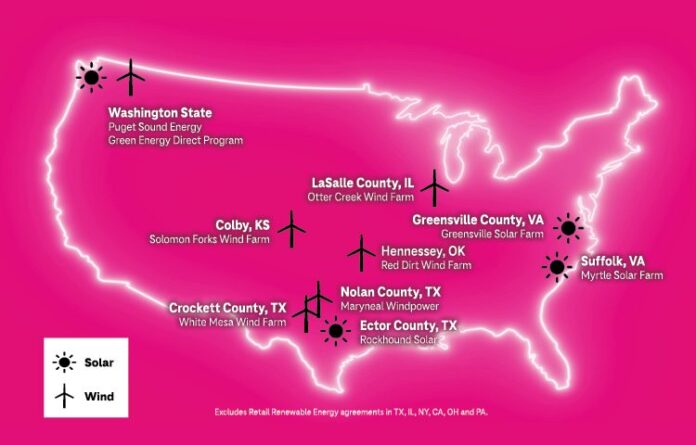T-Mobile US says it’s now 100% powered by renewable energy
The ICT sector has an interesting role to play in driving international, national and corporate sustainability strategies. The ICT sector itself is taking strides to lower its carbon emissions and the technology it delivers to customers to further drive sustainability in other verticals. Operators are making relevant investments with T-Mobile US this week claiming a first in the United States—the company says that 100% of its power needs are met by renewable energy sources.
The operator has pursued a multi-pronged renewables strategy with wind and solar delivering 3.4 million MWh annually. T-Mobile US said it’s engaged in eight virtual power agreements, 19 retail agreements, one Green Direct program, and by using Renewable Energy Certificates, essentially a transferable energy-based financial instrument.
Partners include the Solomon Forks Wind Farm in Kansas, the Red Dirt Wind Farm in Oklahoma, the Myrtle Solar Farm in South Carolina, and three wind and solar providers in Texas, among others.
CEO Mike Sievert said in a statement: “T-Mobile put a stake in the ground as the first telecom to commit to going all in on renewable energy by the end of 2021, and now we’re the first to hit this milestone years ahead of others. This was no easy task, but we set a goal and we achieved it. Today, thanks to amazing efforts from a team who was unwavering in our commitment to reduce our impact on the planet, the Un-carrier is powering America’s largest, fastest and most reliable 5G network with 100% clean electricity.”
T-Mobile’s efforts speak to the role of network operators and communications service providers in fostering sustainability goals. In the context of 5G, there’s a tricky dissonance between using more spectrum and more infrastructure to move more data but in a manner that’s more power efficient than LTE.
Mike Murphy, CTO of Ericsson North America, said operators can break the so-called energy curve with 5G by taking a holistic approach. “Practically what that means is network modernization, so upgrade of equipment. Energy-smart operations, meaning how you use it, and looking at different renewable energy sources. But we believe by doing it right, you can actually reduce total energy consumption over time form where we are now.”
Beyond the clear benefits of investing in a cleaner environment, there’s also an associated business value derived from sustainability. As Murphy point out, banks and financial institutions consider corporate sustainability roadmaps in valuing businesses.
Sustainability is “not just about helping yourself,” he said. “It’s become a business imperative. And so it’s a business imperative in general, and our customers are putting demands on us to support them in this regard. And that’s showing up in RFPs…The whole ecosystem is moving towards a situation where business success demands a strong sustainability program as well.”

